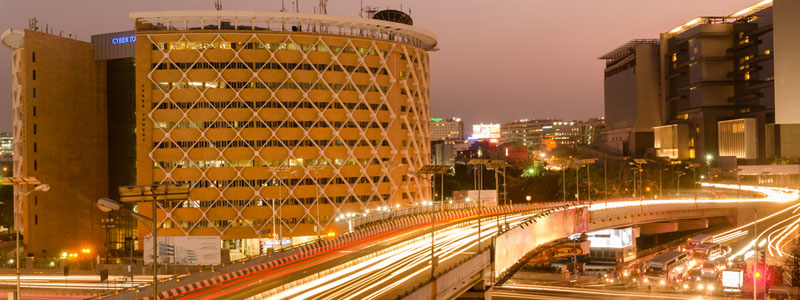
South Asia uniquely positioned to become an export powerhouse: World Bank
Bidhu Bhushan Palo | @TheDollarBiz

View of the Cyber Towers building in Hyderabad, India, which is considered as heritage building for the IT industry in South India. Services exports are forecast to become the mainstay of South Asia's exports in coming years
South Asia’s robust performance in exports is likely to continue in the coming years led by increasing diversification of exports and economic growth in India, the World Bank says in a new report. South Asia’s exports have steadily grown in the recent years, and in 2013, export growth in Bangladesh, India and Pakistan outperformed “Export Tigers” such as China, Thailand, Indonesia and Malaysia.
 Source - World Bank
Source - World BankSouth Asia’s exports are also growing in importance for the regional economies, a trend that places the export sector on the priority list of governments. According to the World Bank, export growth in South Asia survived the global recession and exports share of GDP in South Asia increased from 8.5% in 1990 to 22% in 2008 and then to 23% in 2013. Much of the growth is led by India, the region’s largest economy. India’s average merchandise export grew around 17.5% in 2000-2013, and this has spurred exports from the region. The World Bank says, “Following India’s exports’ boom, many South Asian economies have displayed some dramatic exports’ growth rates since 2000. And the trend is not driven by more favourable prices: export volumes are growing, especially since the global crisis.” Services exports are also growing rapidly and could become the pillar of South Asian export growth in the coming years, says the World Bank. One of the factors driving South Asian exports is diversification, which protects the region from external shocks. South Asia is now one of the most diversified developing regions in the world, second only to Europe and Central Asia. “The region’s export concentration declined from 3.7 in early 1990s to 3.3 in 2010, while in most other regions it remained relatively stable,” says the World Bank. Within the region, export diversification is highest in India. According to the World Bank, export diversification in South Asia is also associated with higher quality and a higher value added of exports.  The coming years could see South Asia become both a major export market and also the manufacturing hub of the world. The economic recovery in USA is likely to boost exports from the region. Meanwhile, labour costs are expected to increase in East Asia. Moreover, economic growth in East Asia is expected to slow down this year in contrast to accelerated growth forecast for South Asia. The World Bank projects that India’s GDP growth will grow from 4.7% in FY2013-14 to 5.6% in FY2014-15 and to 6.4% in FY2015-16. Overall, South Asia’s economy will expand by 6% in 2015 and by 6.4% in 2016 compared to 5.4% this year. However, economic growth in East Asia and the Pacific is expected to decline from 7.2% in 2013 to 6.9% this year and in 2015. "The region also remains vulnerable to a sharp slowdown in China," says the World Bank. These changes provide an opportunity for India and other South Asian countries. “South Asia has a unique opportunity to become an export powerhouse, especially in light manufacturing sectors. And the region is well placed to seize this opportunity,” says the World Bank. “The outlook over the next years for South Asia indicates broad economic stability and a pick-up in growth with potential risks concentrated on the fiscal and structural reform side,” says Martin Rama, Chief Economist for South Asia, World Bank.
The coming years could see South Asia become both a major export market and also the manufacturing hub of the world. The economic recovery in USA is likely to boost exports from the region. Meanwhile, labour costs are expected to increase in East Asia. Moreover, economic growth in East Asia is expected to slow down this year in contrast to accelerated growth forecast for South Asia. The World Bank projects that India’s GDP growth will grow from 4.7% in FY2013-14 to 5.6% in FY2014-15 and to 6.4% in FY2015-16. Overall, South Asia’s economy will expand by 6% in 2015 and by 6.4% in 2016 compared to 5.4% this year. However, economic growth in East Asia and the Pacific is expected to decline from 7.2% in 2013 to 6.9% this year and in 2015. "The region also remains vulnerable to a sharp slowdown in China," says the World Bank. These changes provide an opportunity for India and other South Asian countries. “South Asia has a unique opportunity to become an export powerhouse, especially in light manufacturing sectors. And the region is well placed to seize this opportunity,” says the World Bank. “The outlook over the next years for South Asia indicates broad economic stability and a pick-up in growth with potential risks concentrated on the fiscal and structural reform side,” says Martin Rama, Chief Economist for South Asia, World Bank.
The World Bank adds that to boost exports, South Asia must focus on improving competitiveness, infrastructure, logistics, efficiency in regulation, and on reducing red tape.
This article was published on October 6, 2014.





 to success.
to success.